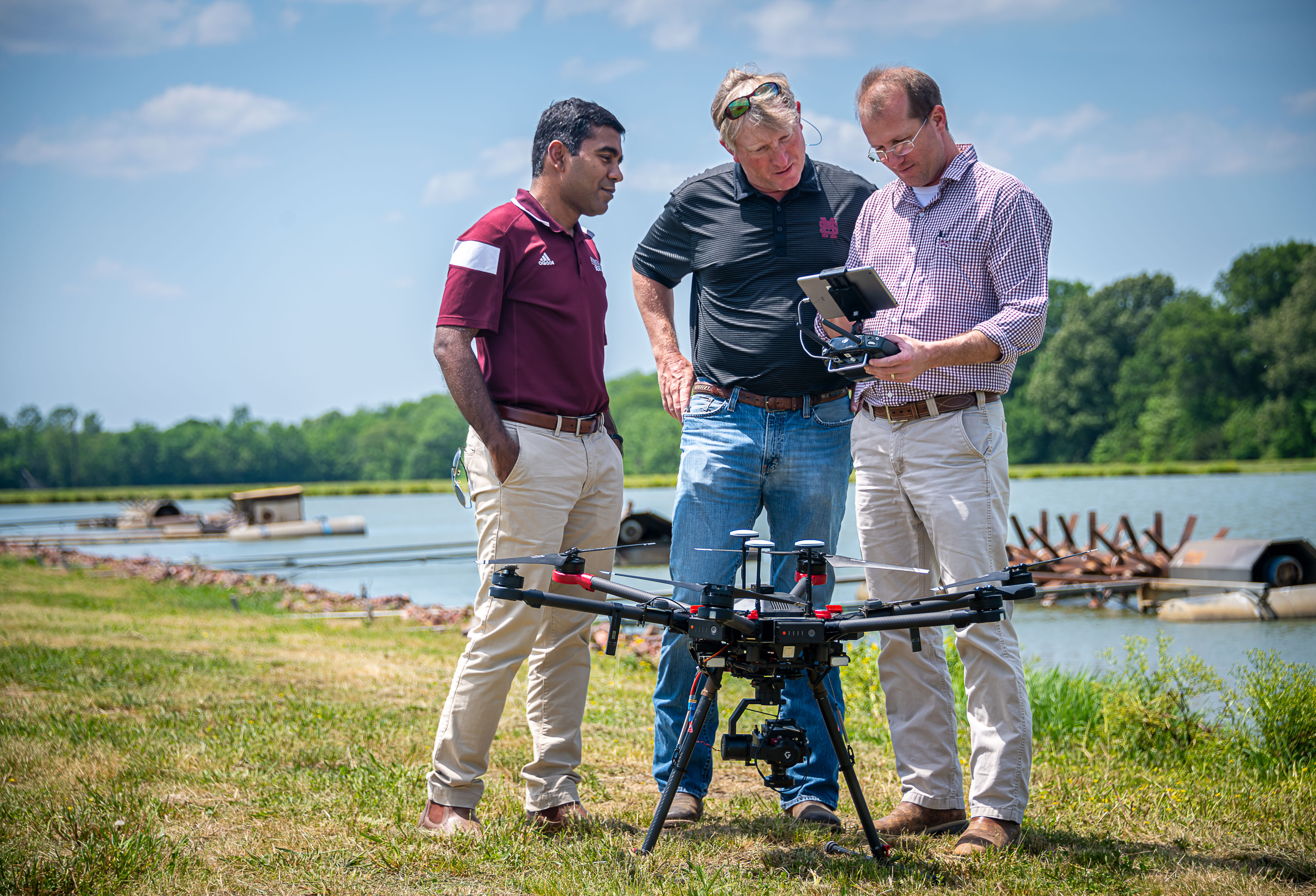The information presented on this page may be dated. It may refer to situations which have changed or people who are no longer affiliated with the university. It is archived as part of Mississippi State University's history.
The largest segment of aquaculture in the U.S. is farm-raised channel catfish with growers producing $437 million in sales in 2023. But historically, blue-green algae has left a bad taste in catfish growers' mouths, adding between $15-$23 million annually to catfish production costs by causing significant harvest delays.
Certain types of blue-green algae, or cyanobacteria, grow in catfish ponds and produce compounds that can have an earthy or muddy flavor. Producers with off-flavor ponds are forced to wait weeks for the compounds to be flushed from the catfish's tissues before they can reach a processing plant. If the fish have already been harvested by the time off-flavor is detected, the grower faces heavy loss.
"Once they're in off-flavor-free water, producers still have to wait and wait and wait. They still have to feed those fish to keep them marketable. So, their feed cost is going up, their fuel costs to drive feed trucks is going up, the cost to run aerators—the electric bills—is just climbing the whole time. They're losing money all during that time to keep those fish alive, hoping that the off-flavor causing compound will clear out of their tissue so they can market their product," said Dr. Gray Turnage, an assistant extension and research professor and MAFES scientist in Mississippi State University's Geosystems Research Institute (GRI).
Turnage is working with Dr. Sathish Samiappan, a research professor who specializes in image processing and machine learning at GRI, to use drone technology as a proactive approach to prevent off-flavor in catfish.
Uncrewed aerial systems, in this case a hexacopter drone, can be mounted with a hyperspectral camera to detect information unseen to the human eye. Turnage and Samiappan's team is focused on calibrating this system so that catfish growers can detect the off-flavor-causing algae with regular flyovers throughout the growing season. Once the algae are detected, producers can apply algaecide to the ponds, preventing the intrusion of off-flavor compounds.
"The camera is imaging the reflectance of light. With the hyperspectral sensor on these drones, every ground material, whether it be a truck or a road or a soybean plant, reflects a unique signature," Samiappan said. "When you look at this signature in the context of catfish ponds, you can tell whether the water is clean or if it has the cyanobacteria that produce off-flavor. All it takes is for the drone to fly over and take an image."
Recent findings from experiments on research catfish ponds at the MSU Thad Cochran National Warmwater Aquaculture Center have given proof of concept to the team's drone system. Their machine learning model was able to differentiate on-flavor ponds from off-flavor ponds.
"After off-flavor was detected in the fish, we flew drones the next day, and the ponds that had off-flavor had a different hyperspectral image compared to ponds that did not. So, we know we can detect the algae in the water with drones," Turnage said. "Now we need to go back and correlate the algal density to off-flavor compound production."
Once they make a correlation between the amount of algae in catfish ponds and presence of the off-flavor causing chemicals, the team can begin to identify when growers should take action to reduce the amount of algae.
"In theory, it'll help us set action thresholds so we can be proactive about the management rather than reactive," Turnage said. "If we can do that, farmers aren't losing income, and it also stabilizes the market because you have a much more stable timeline from the day you start the fish growing to the day you know they're going to market."
Turnage said that once the UAS system is firmly proven and made affordable, the next step will be to train growers and encourage the adoption of the new drone technology within aquaculture.
"The idea is to transform the way producers manage aquaculture. We're using catfish ponds as a test mechanism to show that drone technology can be used to enhance and stabilize the market," Turnage said. "It's going to take changes in the way people manage ponds, but we believe it's feasible. If you can do it in catfish ponds, it can be scaled to other facets of the aquaculture world—baitfish production, pet fish production, crawfish production, or whatever."
The research was funded by the USDA Agricultural Research Service through the Mississippi Center for Enhancing Utilization and Safety of Catfish and Other Aquatic Foods research program, a collaborative effort between MSU and the USDA-ARS. Daniel McCraine, a research engineer at GRI, performed hyperspectral data collection and pre-processing and mentored Jennefer Jones, a senior electrical engineering student in the Bagley College of Engineering, who performed analysis on the data. In addition to Turnage and Samiappan, the research team includes Drs. David Wise, professor in wildlife, fisheries and aquaculture and director of the Thad Cochran National Warmwater Aquaculture Center; Wes Lowe, assistant professor in agricultural and biological engineering; and Brad Richardson, research fish biologists with the USDA-ARS Warmwater Aquaculture Research Unit.
In theory, this research will help us set action thresholds so we can be proactive about the management rather than reactive. If we can do that, farmers aren't losing income, and it also stabilizes the market because you have a much more stable timeline from the day you start the fish growing to the day you know they’re going to market.
Dr. Gray Turnage
Behind the Science

Gray Turnage
Assistant Research/Extension Professor
Education: B.S., M.S., Biological Sciences; Ph.D., Weed Science, Mississippi State University
Years At MSU: 13
Focus: Natural resource management in wetland and aquatic ecosystems
Passion At Work: I'm passionate about improving management of our natural resources to help conserve them for future generations.

Sathish Samiappan
Professor
Education: B.S., Electronics and Communications Engineering, Bharathiar University, India; M.S., Computer Science and Engineering, Amrita University, India; Ph.D., Electrical and Computer Engineering, Mississippi State University
Years At MSU: 15
Focus: Applying machine learning, computer vision and geospatial technologies, including uncrewed aerial systems (UAS) and hyperspectral imaging, to various applications in agriculture, wildlife ecology, and conservation
Passion At Work: Imaging and image recognition has been my passion for as long as I can remember.


